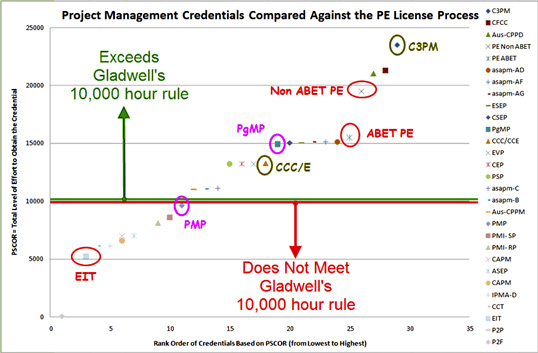Results
Within the limits of this model as outlined earlier, Figure 1 illustrates the rank ordered results of our research.
 ***(Click on image for a larger view)***
***(Click on image for a larger view)***
Figure 1: Ranking of Certifications based on cumulative score of experience and assessment
As can be seen in Figure 1, the PRINCE2 credentials are significantly lower than all other credentials because no work experience or educational are required, combined with what appears to be a relatively weak testing/assessment process. At the other extreme, AACE's top credentials, the C3PM and the CFCC, scored very high. This is due to the requirements of high levels of demonstrated experience, a Master's degree or equivalency in terms of education with extensive peer review of papers, work outputs and other indicators of competency.
Do the numbers make sense? Once again we relied on first-hand experience with both PMI's PMP and AACE's CCC/E, i.e. from taking and passing both exams, as well as 20+ years of experience providing training helping others to prepare to take these exams. From this we know that the level of preparation effort to earn the CCC/E (~240 hours of study time) is roughly double that of the PMP (~120 hours of study time). With a PSCOR score for the PMP of 9624 and a PSCOR score for the CCC/E of 13261, (138% vs. 200%) perhaps the model needs fine tuning in this area. Either the lower scoring credentials are being over-rated or the higher scoring credentials are being under-rated. This clearly needs more research.
Moreover, there seems to be a general consensus that the PMP (PSCOR = 9624) is higher than asapm/IPMA's Level D (PSCOR - 6132) but lower than asapm/IPMA Level C (PSCOR = 11106). In this case, the PSCOR scores reaffirm what many have been stating intuitively, but have had no empirical proof supporting this claim. This would put PMI's PMP a little over half way between the IPMA Level D and IPMA Level C. While a debate has raged for many years now, this model or some refinement of it, will help quantify exactly how these credentials relate to one another.
The last observation that alerts us to more refinement of the scoring model is that the PMP has a PSCOR of 9624 while the PRINCE2 Practitioner (P2P) has a PSCOR of only 78. This indicates the need for much more research on how to fairly and accurately score the various credentials. Knowing the PRINCE2 credentials to be "credible", at least based on market acceptance, is this model being fair? And if not, what is the right or best model that will provide the most accurate assessment?
|



